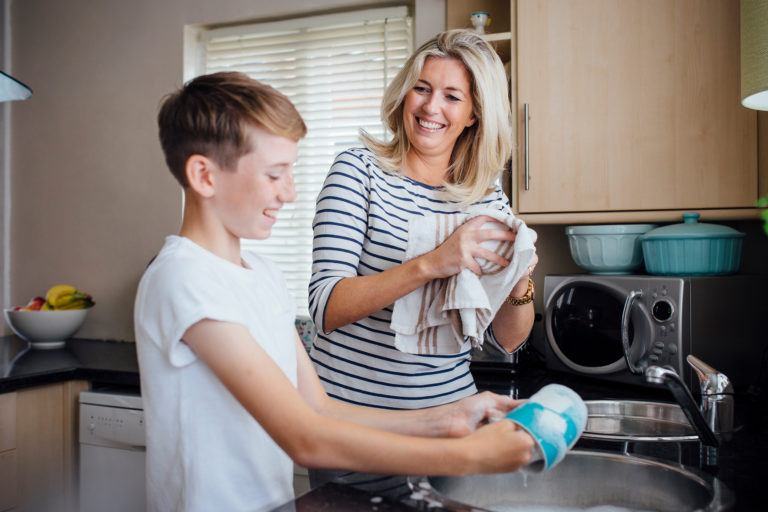
Quick Tips
- To keep a house clean, you'll need to get rid of stuff.
- Replace synthetic, toxic cleaners with natural, green cleaners.
- Organize, organize, and organize.
- Create routines, break bad habits.
- Be careful what you bring into your clean home.
- Remember, the popular notion of "clean" is insane.
There was an interesting study that took place in 2002 at the University of Glasgow. Researchers found that cleaning and doing chores causes depression. Yes. It will go down as the most pointless research ever conducted. Cleaning isn’t fun; people should do as little of it as possible. However, that runs contrary to our very way of life. If your house doesn’t sparkle and smell like an ocean breeze, you’re a reckless failure, right? But of course our culture is completely psychotic. Clean doesn’t have a smell. Clean is organized and clutter free. Clean keeps your family happy and healthy, but it need not sparkle or smell like a pine tree apocalypse.
Below I’ve detailed how to clean a house. Our philosophy is that house cleaning should be easy, low maintenance, and non-toxic. My guide is not about specifics, but general principles. Unlike other, more insulting “how to” websites, we assume you have some working knowledge of elbow grease and dustpans. This article may not result in a clean house overnight, but it may just change the way you think about your home and house cleaning.
How to Clean House
 To keep a house clean, you’ll need to get rid of stuff.The more things you have, the more things you’ll need to clean and maintain. If all your horizontal space is covered, and you have to be nimble to get from one room to the next, you probably have too much stuff. Maids can deep clean luxury hotel suites in less than 30 minutes. How? These rooms aren’t filled with stuff. A perpetually clean house – the kind you want to come home to – is open and clutter free. Getting rid of clutter – the unloved, unused stuff in your house – will not only greatly reduce the time you spend cleaning, but also the time you spend scouring your home while looking for lost items among the detritus. Goodwill, churches, temples, garage sales – you have many options.
To keep a house clean, you’ll need to get rid of stuff.The more things you have, the more things you’ll need to clean and maintain. If all your horizontal space is covered, and you have to be nimble to get from one room to the next, you probably have too much stuff. Maids can deep clean luxury hotel suites in less than 30 minutes. How? These rooms aren’t filled with stuff. A perpetually clean house – the kind you want to come home to – is open and clutter free. Getting rid of clutter – the unloved, unused stuff in your house – will not only greatly reduce the time you spend cleaning, but also the time you spend scouring your home while looking for lost items among the detritus. Goodwill, churches, temples, garage sales – you have many options. Replace synthetic, toxic cleaners with natural, green cleaners. Whenever possible, household cleaners should be food grade. Salt, vinegar (white and cider), baking soda, vodka, lemon juice, essential oils, water – these are our cleaning staples at How to Clean Things. If you want to purchase commercial green cleaners, look for the USDA organic seal or the Green Seal. Better yet, don’t buy any cleaning product that doesn’t specifically list all contents on the package. Companies have no reason (or right) to hide this information, aside from not alarming customers. Don’t know what a chemical is or how to pronounce it? Do some searching online. The EPA (Environmental Protection Agency) and the EWG (Environmental Working Group) are great places to start.
Replace synthetic, toxic cleaners with natural, green cleaners. Whenever possible, household cleaners should be food grade. Salt, vinegar (white and cider), baking soda, vodka, lemon juice, essential oils, water – these are our cleaning staples at How to Clean Things. If you want to purchase commercial green cleaners, look for the USDA organic seal or the Green Seal. Better yet, don’t buy any cleaning product that doesn’t specifically list all contents on the package. Companies have no reason (or right) to hide this information, aside from not alarming customers. Don’t know what a chemical is or how to pronounce it? Do some searching online. The EPA (Environmental Protection Agency) and the EWG (Environmental Working Group) are great places to start.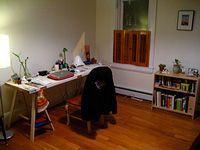 Organize, organize, and organize. Organizers and good organization will increase the surface area in your home. It will also reduce the amount of time you spend cursing, crying, and pleading with God while looking for misplaced items. Anyone preaching how to clean a house is going to focus on organizing. They will tell you, “A place for everything and everything in its place”. Perhaps you’ll need to purchase organizers. Department stores devote whole aisles to organizers of all shapes and sizes. Magazines like Real Simple and Good Housekeeping often have easy, DIY organizing solutions in every issue. Sit down, brainstorm, and think of ways to best utilize your space.
Organize, organize, and organize. Organizers and good organization will increase the surface area in your home. It will also reduce the amount of time you spend cursing, crying, and pleading with God while looking for misplaced items. Anyone preaching how to clean a house is going to focus on organizing. They will tell you, “A place for everything and everything in its place”. Perhaps you’ll need to purchase organizers. Department stores devote whole aisles to organizers of all shapes and sizes. Magazines like Real Simple and Good Housekeeping often have easy, DIY organizing solutions in every issue. Sit down, brainstorm, and think of ways to best utilize your space.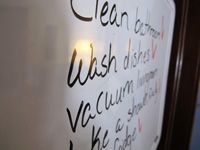 Create routines, break bad habits. You want to avoid the pristine clean to deplorable, get-the-kids-taken-away cycle that most people experience when it comes to house cleaning. A consistently clean house will reduce stress and free up time, but for this you’ll need to be consistent. If you live with others, try picking rooms – each person being responsible for maintaining a specific space. Or, put up a marker board and list chores (to be crossed out) on a daily basis. Use a calendar. Studies have shown that it takes around three weeks to make or break a habit. Get everyone in your home to buy in to whatever system you have in mind. After it becomes habit, things will get easier.
Create routines, break bad habits. You want to avoid the pristine clean to deplorable, get-the-kids-taken-away cycle that most people experience when it comes to house cleaning. A consistently clean house will reduce stress and free up time, but for this you’ll need to be consistent. If you live with others, try picking rooms – each person being responsible for maintaining a specific space. Or, put up a marker board and list chores (to be crossed out) on a daily basis. Use a calendar. Studies have shown that it takes around three weeks to make or break a habit. Get everyone in your home to buy in to whatever system you have in mind. After it becomes habit, things will get easier. Be careful what you bring into your clean home. If there is a place for everything and everything has a place, something should be displaced every time you bring new things into the home. Magazines need not be saved – that’s what libraries are for. Stop getting junk mail by signing up for opt-out programs. Don’t buy things the moment you desire them – sleep on it; according to numerous studies, only one percent of the things Americans buy are still in use after six months. One percent! So, one of the best things you can do to clean a house and keep it that way is to not buy $#!^. One word of caution: careful, calculated spending often leads to swelling of the bank account and/or wallet.
Be careful what you bring into your clean home. If there is a place for everything and everything has a place, something should be displaced every time you bring new things into the home. Magazines need not be saved – that’s what libraries are for. Stop getting junk mail by signing up for opt-out programs. Don’t buy things the moment you desire them – sleep on it; according to numerous studies, only one percent of the things Americans buy are still in use after six months. One percent! So, one of the best things you can do to clean a house and keep it that way is to not buy $#!^. One word of caution: careful, calculated spending often leads to swelling of the bank account and/or wallet.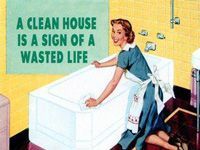 Remember, the popular notion of “clean” is insane. We have been trained to over-clean – to be ashamed of even the slightest disorder in our homes. Every surface is supposed to glisten, smell like a mountain stream, and be completely devoid of any microbes – even the beneficial ones. But our immune systems are supposed to rub elbows with the world. Many doctors and researchers blame over-cleaning and household chemicals for health problems like asthma, allergies, eczema, and more. We all need to pull up our sleeves and remove the twig from our anuses. Yeah, you should probably wash your hands afterwards, but don’t go crazy.
Remember, the popular notion of “clean” is insane. We have been trained to over-clean – to be ashamed of even the slightest disorder in our homes. Every surface is supposed to glisten, smell like a mountain stream, and be completely devoid of any microbes – even the beneficial ones. But our immune systems are supposed to rub elbows with the world. Many doctors and researchers blame over-cleaning and household chemicals for health problems like asthma, allergies, eczema, and more. We all need to pull up our sleeves and remove the twig from our anuses. Yeah, you should probably wash your hands afterwards, but don’t go crazy.
Why Clean a House with Green Cleaners?
I’m not an alarmist. I’m careful. Our food is heavily regulated by the Food and Drug Administration to keep us healthy and safe. Our chemicals, by comparison, are almost completely unregulated. The EPA (Environmental Protection Agency) is supposed to be safeguarding us, but they are comically (tragically?) underfunded. The EPA has reported as much on numerous occasions. Most of the chemicals on the market today have not been tested for toxicity. They are innocent until proven guilty. Consider lead. Lead was known to be highly dangerous since the founding of America, yet it was only discontinued from use in paints and gasoline in the 70’s. This is not an isolated case. Consider DDT and the other chemicals included in the “Dirty Dozen”, banned only after irreparable damage was done, and we haven’t seen the end of that. Chemical companies turn us all into guinea pigs, and yet I’ve never received a check for it. Companies are sometimes asked to voluntarily test their chemicals, but of course they do the testing. Not entirely disinterested in the outcome, are they? The green movement is very much about our use of chemicals. Our cleaners, our fuels, our pesticides, our products – we want to know what’s in them. We want actual testing and accountability. Until that time, I’ll play it safe and protect my family.
Clean House Resources
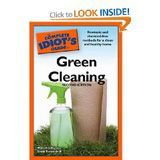 The Complete Idiot’s Guide to Green Cleaning.This book is a great starting point for idiots and intellectuals alike. Inside you’ll find out how to clean a house moving from room to room, chore to chore. The book contains oodles of recipes for green cleaners, as well as many practical, time-saving tips. Like many in the “Idiot’s Guide” series, the bullets, headings, and lists make this book an incredibly fast read.
The Complete Idiot’s Guide to Green Cleaning.This book is a great starting point for idiots and intellectuals alike. Inside you’ll find out how to clean a house moving from room to room, chore to chore. The book contains oodles of recipes for green cleaners, as well as many practical, time-saving tips. Like many in the “Idiot’s Guide” series, the bullets, headings, and lists make this book an incredibly fast read.
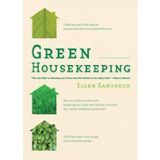 Organic Housekeeping by Ellen Sandbeck. Writing for a green house-cleaning website, I’ve read much of the literature on the subject. This book is the most thorough, practical, and readable book I’ve come across to date. Sandbeck is an organic gardener who took her understanding of health and ecosystems and articulately applied it to house cleaning. You’ll learn about green cleaning options, green products, but also much about everyday organization. This book is great for quick referencing, but it is worth reading from cover to cover. Speaking of which, why not try the Kindle Version of Organic Housekeeping? Less clutter around the house!
Organic Housekeeping by Ellen Sandbeck. Writing for a green house-cleaning website, I’ve read much of the literature on the subject. This book is the most thorough, practical, and readable book I’ve come across to date. Sandbeck is an organic gardener who took her understanding of health and ecosystems and articulately applied it to house cleaning. You’ll learn about green cleaning options, green products, but also much about everyday organization. This book is great for quick referencing, but it is worth reading from cover to cover. Speaking of which, why not try the Kindle Version of Organic Housekeeping? Less clutter around the house!
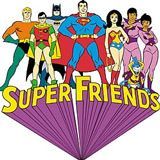 Friends and Neighbors. Many hands make light work. To clean a house that is tragically out of control, sometimes you need help. You’ll undoubtedly be lifting things, which can be unsafe and costly when done alone. It may be embarrassing to have people walking around your unkempt home, but you may just learn things along the way. We are not all gifted with domestic charm. Perhaps they’ll even volunteer to take some of your stuff home.
Friends and Neighbors. Many hands make light work. To clean a house that is tragically out of control, sometimes you need help. You’ll undoubtedly be lifting things, which can be unsafe and costly when done alone. It may be embarrassing to have people walking around your unkempt home, but you may just learn things along the way. We are not all gifted with domestic charm. Perhaps they’ll even volunteer to take some of your stuff home.
 Greenhome.com Cleaners aren’t the only villains lurking in our homes. Our furniture, counters, flooring, and beds – the chemicals in these products are also basically unregulated. For example, most pillow manufacturers use known neurotoxins as a flame retardant. Many types of new furniture and flooring will outgas VOCs (volatile organic compounds) for years after purchase. The green movement has given rise to all kinds of retailers that sell products that won’t harm you or the environment. Greenhome.com sells green products of all kinds. Also: if you’re worried about the chemicals in your cosmetics and personal care products, check out cosmeticsdatabase.com.
Greenhome.com Cleaners aren’t the only villains lurking in our homes. Our furniture, counters, flooring, and beds – the chemicals in these products are also basically unregulated. For example, most pillow manufacturers use known neurotoxins as a flame retardant. Many types of new furniture and flooring will outgas VOCs (volatile organic compounds) for years after purchase. The green movement has given rise to all kinds of retailers that sell products that won’t harm you or the environment. Greenhome.com sells green products of all kinds. Also: if you’re worried about the chemicals in your cosmetics and personal care products, check out cosmeticsdatabase.com.